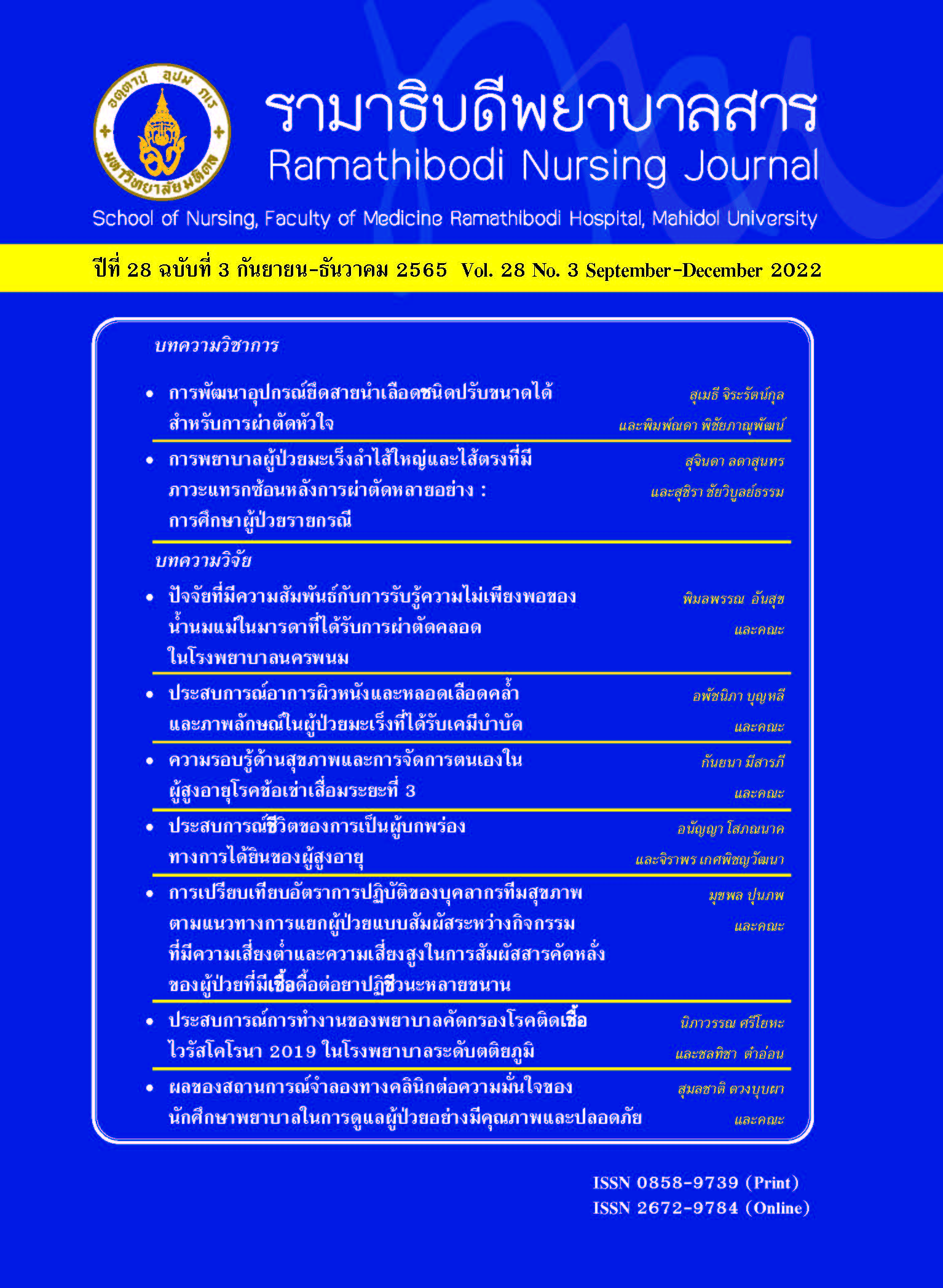The Development of a Universal Line Locker for Cardiac Surgery
Main Article Content
Abstract
The arterial and venous tubing is a crucial part of the cardiopulmonary bypass (CPB) system because it functions as the great vessel of the patient. Therefore, securing devices to prevent disposition or dislodgement of the tubing lines is very important.The limitation of original securing devices is that they are less flexible, take a long time to prepare, and more increase the risk of losing swabs. The strengths of the universal line lockers are locally available material, inexpensive, and easily adjusted during procedures. The universal line locker is designed to reduce the preparation complexity and facilitate the surgeon’s operation faster and safer. The reused material is purposefully used to make the universal line locker to reduce global waste. After the pilot test, the overall level of satisfaction from surgeons, scrub nurses, and perfusionists is excellent.The universal line locker can be used in clinical practice to promote safety for patients and operators.
Keywords: Universal line locker, Cardiac surgery, Cardiopulmonary bypass
Article Details

This work is licensed under a Creative Commons Attribution-NonCommercial-NoDerivatives 4.0 International License.
บทความ ข้อมูล เนื้อหา รูปภาพ ฯลฯ ที่ได้รับการตีพิมพ์ในรามาธิบดีพยาบาลสาร ถือเป็นลิขสิทธิ์ของวารสาร หากบุคคลหรือหน่วยงานใดต้องการนำทั้งหมดหรือส่วนหนึ่งส่วนใดไปเผยแพร่หรือเพื่อกระทำการใด ใด จะต้องได้รับอนุญาตเป็นลายลักษณ์อักษรจากรามาธิบดีพยาบาลสารก่อนเท่านั้น
References
Organization WH. Who reveals leading causes of death and disability worldwide: 2000-2019. 2020 [cited 2021 March 3]. Available from: https://www.who.int/news/item/09-12-2020-who-reveals-leading-causes-ofdeath-and-disability-worldwide-2000-2019
The Society of Thoracic Surgeons of Thailand. Statistic of cardiac surgery in thailand 2019 [cited 2021 Aug 31].Available from: https://ststhai.org/en/stats/#(in Thai)
Charrière JM, Pélissié J, Verd C, Léger P, Pouard P, de Riberolles C, et al. Survey: a retrospective survey of monitoring/safety devices and incidents of cardiopulmonary bypass for cardiac surgery in france. J Extra Corpor Technol. 2007;39(3):142-59.
Singha S, Karim H, Panda C. Cardiopulmonary bypass:basic principles and updates in anaesthetic management.ARC J Anesthesiol. 2018;3:14-20.
Pongsukwetchakul T, Chiannikulchai N. Development the clip lock for strap sterile operating microscope drape and evaluation of its effectiveness. Ramathibodi Nursing Journal. 2018;24(2):163-77. (in Thai)
Bhumisirikul P, Chiannilkulchai N. Development of a rama gallbladder retrieval bag for improved patient safety: a nursing innovation. Pacific Rim Int J Nur Res.2018;22(3):264-77.
Chiannilkulchai N, Bhumisirikul P. Effectiveness of rotating stringer in sterilization process. Pacific Rim Int J Nur Res. 2020;24(4):502-13.
Kikuta K, Misaki D. Development of medical device design method considering human-centered design. J Res Appl Mech Eng. 2020;8(1):59-66.
Shah SG, Robinson I. User involvement in healthcare technology development and assessment: structured literature review. Int J Health Care Qual Assur Inc Leadersh Health Serv. 2006;19(6-7):500-15.
Wahr JA, Prager RL, Abernathy JH, Martinez EA, Salas E, Seifert PC, et al. Patient safety in the cardiac operating room: human factors and teamwork. Circulation.2013;128(10):1139-69.
Schabel RK, Berryessa RG, Justison GA, Tyndal CM,Schumann J. Ten common perfusion problems: prevention and treatment protocols. J Extra Corpor Technol.1987;19(3):392-8.
Blandford A, Furniss D, Vincent C. Patient safety and interactive medical devices: realigning work as imagined and work as done. Clin Risk. 2014;20(5):107-10.
Vincent C, Blandford A. Designing for safety and usability:user-centered techniques in medical device design practice. Proc Hum Factors Ergon Soc Annu Meet.2011;55(1):793-7.
Martin JL, Norris BJ, Murphy E, Crowe JA. Medical device development: the challenge for ergonomics. Appl Ergon. 2008;39(3):271-83.
Lang AR, Martin JL, Sharples S, Crowe JA. The effect of design on the usability and real world effectiveness of medical devices: a case study with adolescent users. Appl Ergon. 2013;44(5):799-810.
16. Miclăuş T, Valla V, Koukoura A, Nielsen AA,Dahlerup B, Tsianos GI, et al. Impact of design on medical device safety. Ther Innov Regul Sci. 2020;54(4):839-49.


